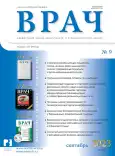Диагностика бессимптомной бактериурии у беременных: рациональные подходы
- Авторы: Сухорукова A.О.1, Степанькова Е.А.1, Покусаева В.Н.1, Лямец Л.Л.1
-
Учреждения:
- Смоленский государственный медицинский университет Минздрава России
- Выпуск: Том 34, № 9 (2023)
- Страницы: 43-46
- Раздел: Из практики
- URL: https://journals.eco-vector.com/0236-3054/article/view/604078
- DOI: https://doi.org/10.29296/25877305-2023-09-09
- ID: 604078
Цитировать
Полный текст
Аннотация
Бессимптомная бактериурия (ББ) во время беременности негативно сказывается на ее течении, а также влияет на акушерские и перинатальные исходы.
Цель. Оптимизировать диагностику ББ у беременных для предотвращения возможных негативных влияний асимптомных инфекций на акушерские и перинатальные исходы.
Материал и методы. В одноцентровое проспективное исследование включили 101 беременную, у которых в I триместре беременности при проведении скринингового бактериологического исследования мочи была выявлена ББ в различных титрах. Всем пациенткам выполнялось повторное бактериологическое исследование мочи с соблюдением всех требований к проведению этого анализа. Проанализированы особенности течения беременности и перинатальные исходы у женщин с выявленной бактериурией в различных титрах. Контрольную группу составили 50 женщин без инфекций мочевых путей в анамнезе.
Результаты. Повторное исследование у 9 (9,0%) пациенток подтвердило бактериурию в титре ≥105 КОЕ/мл, у 65 (70,6%) – в титре 102–104 КОЕ/мл, у 27 (29,4%) обследуемых роста этиологически значимых микроорганизмов не обнаружено. В ходе изучения результатов первичных посевов мочи моноинфекция выявлена в 72,3% случаев, варианты сочетания двух микроорганизмов – в 27,7%. Регионарная структура повторно выделенных уропатогенов представлена преимущественно Enterobacterales. При повторном бактериологическом исследовании мочи до проведения антибактериальной терапии ББ в значимом титре повторно подтвердилась только у 9 пациенток (95% доверительный интервал – 0,042–0,162; p=0,029). Бактериурия даже при однократном выделении возбудителя в низком титре во время беременности ассоциирована с повышенной вероятностью развития анемии легкой степени и артериальной гипертензии.
Заключение. Даже однократное обнаружение уропатогенов в моче беременных, в том числе с низким диагностическим титром 102–104 КОЕ/мл, ассоциировано с неблагоприятным течением беременности.
Ключевые слова
Полный текст
Об авторах
A. О. Сухорукова
Смоленский государственный медицинский университет Минздрава России
Автор, ответственный за переписку.
Email: anastasiasukhoruckova@yandex.ru
ORCID iD: 0000-0002-2518-7831
Россия, Смоленск
Е. А. Степанькова
Смоленский государственный медицинский университет Минздрава России
Email: anastasiasukhoruckova@yandex.ru
ORCID iD: 0000-0001-5516-2793
доктор медицинских наук, профессор
Россия, СмоленскВ. Н. Покусаева
Смоленский государственный медицинский университет Минздрава России
Email: anastasiasukhoruckova@yandex.ru
ORCID iD: 0000-0003-4326-7007
доктор медицинских наук
Россия, СмоленскЛ. Л. Лямец
Смоленский государственный медицинский университет Минздрава России
Email: anastasiasukhoruckova@yandex.ru
ORCID iD: 0000-0002-9173-3044
кандидат технических наук, доцент
Россия, СмоленскСписок литературы
- Городовская Н.Б., Коротчаева Ю.В. Бессимптомная бактериурия у беременных: диагностика и лечение. Альманах клинической медицины. 2014; 30: 57–60 [Gordovskaya N.B., Korotchaeva I.V. Asymptomatic bacteriuria in pregnant women: diagnostics and treatment. Almanac of Clinical Medicine. 2014; 30: 57–60 (in Russ.)]. doi: 10.18786/2072-0505-2014-30-57-60
- Каптильный В.А. Инфекция мочевыводящих путей во время беременности. Архив акушерства и гинекологии им В.Ф. Снегирева. 2015; 2 (4): 10–9 [Kaptilyy V.A. Urinary tract infection in pregnancy. V.F. Snegirev Archives of Obstetrics and Gynecology. 2015; 2 (4): 10–9 (in Russ.)].
- Nahab H.M., Akeel Hamed Al-Oebady M., Aqeel Abdul Munem H. Bacteriological Study of Urinary Tract Infections among Pregnant Women in Al Samawa City of Iraq. Arch Razi Inst. 2022; 77 (1): 117–22. doi: 10.22092/ARI.2021.356676.1889
- Козырев Ю.В., Густоварова Т.А. Бессимптомная бактериурия у беременных. Вестник Смоленской государственной медицинской академии. 2011; 4: 36–42 [Kozyrev Yu.V., Gustovarova T.A. Asymptomatic bacteriuria in pregnant women. Vestnik Smolenskoi gosudarstvennoi meditsinskoi akademii. 2011; 4: 36–42 (in Russ.)].
- Козырев Ю.В., Густоварова Т.А., Крюковский С.Б. Распространенность, факторы риска, эффективность и безопасность антимикробной терапии бессимптомной бактериурии у беременных. Вестник новых медицинских технологий. 2012; 19 (3): 135–7 [Kozyrev Yu.A., Gustovarova T.A., Kryukovsky S.B. The expension, the factors of risk, the effectiveness and the safety of antimicrobic therapy of asymptomatic bacteriuria in the pregnant women. Journal of New Medical Technologies. 2012; 19 (3): 1357 (in Russ.)].
- Betschart C., Albrich W.C., Brandner S. et al. Guideline of the Swiss Society of Gynaecology and Obstetrics (SSGO) on acute and recurrent urinary tract infections in women, including pregnancy. Swiss Med Wkly. 2020; 150: w20236. doi: 10.4414/smw.2020.20236
- Backe B., Jacobsen A.F., Magnussen E.B. et al. Routine urine culture in pregnancy – it needs to stop. Tidsskr Nor Laegeforen. 2020; 140 (17) (in Norwegian). doi: 10.4045/tidsskr.20.0838
- Matuszkiewicz-Rowińska J., Małyszko J., Wieliczko M. Urinary tract infections in pregnancy: old and new unresolved diagnostic and therapeutic problems. Arch Med Sci. 2015; 11 (1): 67–77. doi: 10.5114/aoms.2013.39202
- Habak P.J., Griggs R.P. Jr. Urinary Tract Infection In Pregnancy. 2022 Jul 5. In: StatPearls [Internet]. Treasure Island (FL): StatPearls Publishing, 2022.
- Захарова И.Н., Османов И.М., Мумладзе Э.Б. и др. Бессимптомная бактериурия: смена общепринятого взгляда. Медицинский совет. 2017; 19: 162–7 [Zakharova I.N., Osmanov I.M., Mumladze E.B. et al. Asymptomatic bacteriuria: change of the common opinion. Medical Council. 2017; 19: 162–7 (in Russ.)]. doi: 10.21518/2079-701X-2017-19-162-167
- Приказ Минздрава России от 20.10.2020 №1130н «Об утверждении Порядка оказания медицинской помощи по профилю «акушерство и гинекология (за исключением использования вспомогательных репродуктивных технологий)» [Order of the Ministry of Public Health of the Russian Federation №1130n of 20 October 2020 "Ob utverzhdenii Poryadka okazaniya meditsinskoy pomoshchi po profilyu «akusherstvo i ginekologija (za isklyucheniem ispol'zovaniya vspomogatel'nykh reproduktivnykh tekh-nologiy)" (in Russ.)].
- Палагин И.С., Сухорукова М.В., Дехнич А.В. и др. Антибиотикорезистентность возбудителей внебольничных инфекций мочевых путей в России: результаты многоцентрового исследования «ДАРМИС-2018». Клиническая микробиология и антимикробная химиотерапия. 2019; 21 (2): 134–46 [Palagin I.S., Sukhorukova M.V., Dekhnich A.V. et al. Antimicrobial resistance of pathogens causing community-acquired urinary tract infections in Russia: results of multicenter study "DARMIS-2018". Clinical Microbiology and Antimicrobial Chemotherapy. 2019; 21 (2): 134–46 (in Russ.)]. doi: 10.36488/cmac.2019.2.134-146
- Клинические рекомендации «Бактериологический анализ мочи». М., 2014 [Clinical guidelines "Bacterial urine analysis". Moscow, 2014 (in Russ.)].
- Медик В.А., Токмачев M.С., Фишман Б.Б. Статистика в медицине и биологии: Руководство. В 2-х томах. Под ред. Ю.М. Комарова. Т.1. Теоретическая статистика. М.: Медицина, 2000; 412 с. [Medik V.A., Tokmachev M.S., Fishman B.B. Statistics in medicine and biology: a guide in 2 vol. Eds. Yu.M. Komarov. V.1. Theoretical statistics. Moscow: Meditsina, 2000; 412 p. (in Russ.)].
Дополнительные файлы






